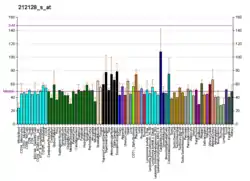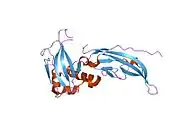Dystroglycan
Dystroglycan is a protein that in humans is encoded by the DAG1 gene.[5][6][7]
Dystroglycan is one of the dystrophin-associated glycoproteins, which is encoded by a 5.5 kb transcript in Homo sapiens on chromosome 3.[8] There are two exons that are separated by a large intron. The spliced exons code for a protein product that is finally cleaved into two non-covalently associated subunits, [alpha] (N-terminal) and [beta] (C-terminal).
Function
In skeletal muscle the dystroglycan complex works as a transmembrane linkage between the extracellular matrix and the cytoskeleton. [alpha]-dystroglycan is extracellular and binds to merosin [alpha]-2 laminin in the basement membrane, while [beta]-dystroglycan is a transmembrane protein and binds to dystrophin, which is a large rod-like cytoskeletal protein, absent in Duchenne muscular dystrophy patients. Dystrophin binds to intracellular actin cables. In this way, the dystroglycan complex, which links the extracellular matrix to the intracellular actin cables, is thought to provide structural integrity in muscle tissues. The dystroglycan complex is also known to serve as an agrin receptor in muscle, where it may regulate agrin-induced acetylcholine receptor clustering at the neuromuscular junction. There is also evidence which suggests the function of dystroglycan as a part of the signal transduction pathway because it is shown that Grb2, a mediator of the Ras-related signal pathway, can interact with the cytoplasmic domain of dystroglycan.
Expression
Dystroglycan is widely distributed in non-muscle tissues as well as in muscle tissues. During epithelial morphogenesis of kidney, the dystroglycan complex is shown to act as a receptor for the basement membrane. Dystroglycan expression in Mus musculus brain and neural retina has also been reported. However, the physiological role of dystroglycan in non-muscle tissues remains unclear.
Interactions
Dystroglycan has been shown to interact with FYN,[9] C-src tyrosine kinase,[9] Src,[9] NCK1,[9] Grb2,[10] Caveolin 3[11] and SHC1.[9]
See also
References
- GRCh38: Ensembl release 89: ENSG00000173402 - Ensembl, May 2017
- GRCm38: Ensembl release 89: ENSMUSG00000039952 - Ensembl, May 2017
- "Human PubMed Reference:". National Center for Biotechnology Information, U.S. National Library of Medicine.
- "Mouse PubMed Reference:". National Center for Biotechnology Information, U.S. National Library of Medicine.
- Skynner MJ, Gangadharan U, Coulton GR, Mason RM, Nikitopoulou A, Brown SD, Blanco G (Jan 1995). "Genetic mapping of the mouse neuromuscular mutation kyphoscoliosis". Genomics. 25 (1): 207–13. doi:10.1016/0888-7543(95)80127-8. PMID 7774920.
- Ibraghimov-Beskrovnaya O, Ervasti JM, Leveille CJ, Slaughter CA, Sernett SW, Campbell KP (Feb 1992). "Primary structure of dystrophin-associated glycoproteins linking dystrophin to the extracellular matrix". Nature. 355 (6362): 696–702. Bibcode:1992Natur.355..696I. doi:10.1038/355696a0. PMID 1741056. S2CID 4273337.
- "Entrez Gene: DAG1 dystroglycan 1 (dystrophin-associated glycoprotein 1)".
- Spence HJ, Dhillon AS, James M, Winder SJ (May 2004). "Dystroglycan, a scaffold for the ERK-MAP kinase cascade". EMBO Reports. 5 (5): 484–9. doi:10.1038/sj.embor.7400140. PMC 1299052. PMID 15071496.
- Sotgia F, Lee H, Bedford MT, Petrucci T, Sudol M, Lisanti MP (Dec 2001). "Tyrosine phosphorylation of beta-dystroglycan at its WW domain binding motif, PPxY, recruits SH2 domain containing proteins". Biochemistry. 40 (48): 14585–92. doi:10.1021/bi011247r. PMID 11724572.
- Yang B, Jung D, Motto D, Meyer J, Koretzky G, Campbell KP (May 1995). "SH3 domain-mediated interaction of dystroglycan and Grb2". The Journal of Biological Chemistry. 270 (20): 11711–4. doi:10.1074/jbc.270.20.11711. PMID 7744812.
- Sotgia F, Lee JK, Das K, Bedford M, Petrucci TC, Macioce P, Sargiacomo M, Bricarelli FD, Minetti C, Sudol M, Lisanti MP (Dec 2000). "Caveolin-3 directly interacts with the C-terminal tail of beta -dystroglycan. Identification of a central WW-like domain within caveolin family members". The Journal of Biological Chemistry. 275 (48): 38048–58. doi:10.1074/jbc.M005321200. PMID 10988290.
Further reading
- Matsumura K, Tomé FM, Collin H, Azibi K, Chaouch M, Kaplan JC, Fardeau M, Campbell KP (Sep 1992). "Deficiency of the 50K dystrophin-associated glycoprotein in severe childhood autosomal recessive muscular dystrophy". Nature. 359 (6393): 320–2. Bibcode:1992Natur.359..320M. doi:10.1038/359320a0. PMID 1406935. S2CID 4326618.
- Apel ED, Roberds SL, Campbell KP, Merlie JP (Jul 1995). "Rapsyn may function as a link between the acetylcholine receptor and the agrin-binding dystrophin-associated glycoprotein complex". Neuron. 15 (1): 115–26. doi:10.1016/0896-6273(95)90069-1. PMID 7619516. S2CID 589282.
- Yang B, Jung D, Motto D, Meyer J, Koretzky G, Campbell KP (May 1995). "SH3 domain-mediated interaction of dystroglycan and Grb2". The Journal of Biological Chemistry. 270 (20): 11711–4. doi:10.1074/jbc.270.20.11711. PMID 7744812.
- Yamada H, Shimizu T, Tanaka T, Campbell KP, Matsumura K (Sep 1994). "Dystroglycan is a binding protein of laminin and merosin in peripheral nerve". FEBS Letters. 352 (1): 49–53. doi:10.1016/0014-5793(94)00917-1. PMID 7925941. S2CID 17529055.
- Gee SH, Montanaro F, Lindenbaum MH, Carbonetto S (Jun 1994). "Dystroglycan-alpha, a dystrophin-associated glycoprotein, is a functional agrin receptor". Cell. 77 (5): 675–86. doi:10.1016/0092-8674(94)90052-3. PMID 8205617. S2CID 54232250.
- Ibraghimov-Beskrovnaya O, Milatovich A, Ozcelik T, Yang B, Koepnick K, Francke U, Campbell KP (Oct 1993). "Human dystroglycan: skeletal muscle cDNA, genomic structure, origin of tissue specific isoforms and chromosomal localization". Human Molecular Genetics. 2 (10): 1651–7. doi:10.1093/hmg/2.10.1651. PMID 8268918.
- Yamada H, Denzer AJ, Hori H, Tanaka T, Anderson LV, Fujita S, Fukuta-Ohi H, Shimizu T, Ruegg MA, Matsumura K (Sep 1996). "Dystroglycan is a dual receptor for agrin and laminin-2 in Schwann cell membrane". The Journal of Biological Chemistry. 271 (38): 23418–23. doi:10.1074/jbc.271.38.23418. PMID 8798547.
- Tian M, Jacobson C, Gee SH, Campbell KP, Carbonetto S, Jucker M (Dec 1996). "Dystroglycan in the cerebellum is a laminin alpha 2-chain binding protein at the glial-vascular interface and is expressed in Purkinje cells". The European Journal of Neuroscience. 8 (12): 2739–47. doi:10.1111/j.1460-9568.1996.tb01568.x. PMID 8996823. S2CID 1707823.
- Matsumura K, Chiba A, Yamada H, Fukuta-Ohi H, Fujita S, Endo T, Kobata A, Anderson LV, Kanazawa I, Campbell KP, Shimizu T (May 1997). "A role of dystroglycan in schwannoma cell adhesion to laminin". The Journal of Biological Chemistry. 272 (21): 13904–10. doi:10.1074/jbc.272.21.13904. PMID 9153251.
- Pirozzi G, McConnell SJ, Uveges AJ, Carter JM, Sparks AB, Kay BK, Fowlkes DM (Jun 1997). "Identification of novel human WW domain-containing proteins by cloning of ligand targets". The Journal of Biological Chemistry. 272 (23): 14611–6. doi:10.1074/jbc.272.23.14611. PMID 9169421.
- Lorenzo LE, Godin AG, Wang F, St-Louis M, Carbonetto S, Wiseman PW, Ribeiro-da-Silva A, De Koninck Y (Jun 2014). "Gephyrin clusters are absent from small diameter primary afferent terminals despite the presence of GABA(A) receptors". The Journal of Neuroscience. 34 (24): 8300–17. doi:10.1523/JNEUROSCI.0159-14.2014. PMC 6608243. PMID 24920633.
- Gesemann M, Brancaccio A, Schumacher B, Ruegg MA (Jan 1998). "Agrin is a high-affinity binding protein of dystroglycan in non-muscle tissue". The Journal of Biological Chemistry. 273 (1): 600–5. doi:10.1074/jbc.273.1.600. PMID 9417121.
- Rambukkana A, Yamada H, Zanazzi G, Mathus T, Salzer JL, Yurchenco PD, Campbell KP, Fischetti VA (Dec 1998). "Role of alpha-dystroglycan as a Schwann cell receptor for Mycobacterium leprae". Science. 282 (5396): 2076–9. Bibcode:1998Sci...282.2076R. doi:10.1126/science.282.5396.2076. PMID 9851927.
- Cao W, Henry MD, Borrow P, Yamada H, Elder JH, Ravkov EV, Nichol ST, Compans RW, Campbell KP, Oldstone MB (Dec 1998). "Identification of alpha-dystroglycan as a receptor for lymphocytic choriomeningitis virus and Lassa fever virus". Science. 282 (5396): 2079–81. Bibcode:1998Sci...282.2079C. doi:10.1126/science.282.5396.2079. PMID 9851928.
- Shimizu H, Hosokawa H, Ninomiya H, Miner JH, Masaki T (Apr 1999). "Adhesion of cultured bovine aortic endothelial cells to laminin-1 mediated by dystroglycan". The Journal of Biological Chemistry. 274 (17): 11995–2000. doi:10.1074/jbc.274.17.11995. PMID 10207021.
- Côté PD, Moukhles H, Lindenbaum M, Carbonetto S (Nov 1999). "Chimaeric mice deficient in dystroglycans develop muscular dystrophy and have disrupted myoneural synapses". Nature Genetics. 23 (3): 338–42. doi:10.1038/15519. PMID 10610181. S2CID 564897.
- Rentschler S, Linn H, Deininger K, Bedford MT, Espanel X, Sudol M (Apr 1999). "The WW domain of dystrophin requires EF-hands region to interact with beta-dystroglycan". Biological Chemistry. 380 (4): 431–42. doi:10.1515/BC.1999.057. PMID 10355629. S2CID 24598356.
- Tommasi di Vignano A, Di Zenzo G, Sudol M, Cesareni G, Dente L (Apr 2000). "Contribution of the different modules in the utrophin carboxy-terminal region to the formation and regulation of the DAP complex". FEBS Letters. 471 (2–3): 229–34. doi:10.1016/S0014-5793(00)01400-9. PMID 10767429. S2CID 21529759.
- James M, Nuttall A, Ilsley JL, Ottersbach K, Tinsley JM, Sudol M, Winder SJ (May 2000). "Adhesion-dependent tyrosine phosphorylation of (beta)-dystroglycan regulates its interaction with utrophin". Journal of Cell Science. 113 ( Pt 10) (10): 1717–26. PMID 10769203.
- Russo K, Di Stasio E, Macchia G, Rosa G, Brancaccio A, Petrucci TC (Jul 2000). "Characterization of the beta-dystroglycan-growth factor receptor 2 (Grb2) interaction". Biochemical and Biophysical Research Communications. 274 (1): 93–8. doi:10.1006/bbrc.2000.3103. PMID 10903901.
External links
- Dystroglycans at the US National Library of Medicine Medical Subject Headings (MeSH)
- Overview at sdbonline.org







